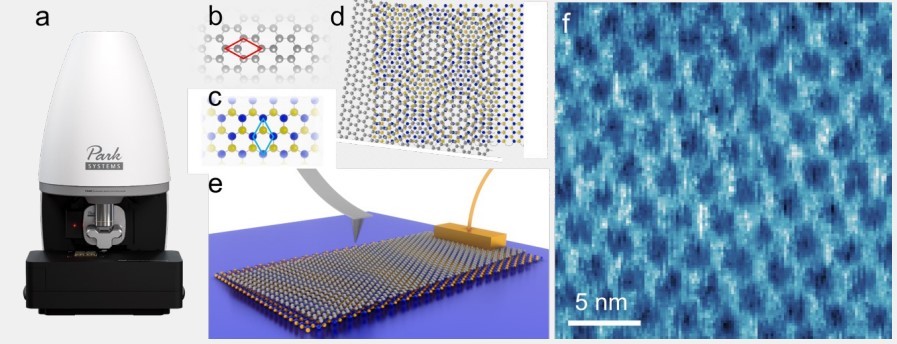Mapping the registry and functional properties of layered materials heterostructures using conductive atomic force microscopy
- 02 Jun 2023
- Volume 24
- NANOscientific Magazine, Spring 2023
J. Kerfoot, V. V. Korolkov. Park Systems UK Ltd, Nottingham, UK
Overview
Manipulating the registry of layers within layered materials heterostructures leads to changes in their functional properties both locally [1,2] and at scales relevant to devices [2,3]. This motivates interest in atomic force microscopy (AFM) as a tool capable of resolving both inter-layer registry and a host of concomitant functional properties at nanometre length scales. Here, we showcase conductive AFM (C-AFM) as a technique capable of determining the registry of layers and extracting functional properties via spectroscopic measurements over individual features. When two rigid layers with a fixed spatial periodicity are overlaid, a moiré pattern may be observed. The symmetry of such features is dependent upon the symmetry of the overlaid layers and the periodicity is dependent upon the mismatch in period of the two features and the angle between them. Moiré patterns can be observed in many situations including in overlaid fabrics and installations such as bridges but most recently moiré patterns have received significant interest for their influence over the functional properties of layered materials heterostructures, namely the field of twistronics [3,4]. One prominent example of where moiré patterns have been explored in layered materials heterostructures is the case of single layer graphene (SLG) on hexagonal boron nitride (hBN). Using hBN as a substrate [5] and encapsulant [6] of SLG enables the fabrication of devices in which the effects of contaminant induced doping is suppressed, yielding stateof-the-art performance characteristics such as mobility. For SLG on hBN, a hexagonal moiré period is seen owing to the hexagonal symmetry and small, ~ 2%, spatial mismatch between hBN and SLG (see figure 1 b-d). Samples were first fabricated by exfoliating both hBN (HQ graphene) and graphene on thermally grown SiO2 before flakes were sequentially picked up and transferred onto pre-deposited contacts using polymeric stamps. After removing polymer residue through solvent immersion and then mechanically by performing contact mode AFM over the area of interest, samples were measured using C-AFM on the Park FX40 automatic AFM with ElectriMulti75-G probes (see fig 1 e and f).
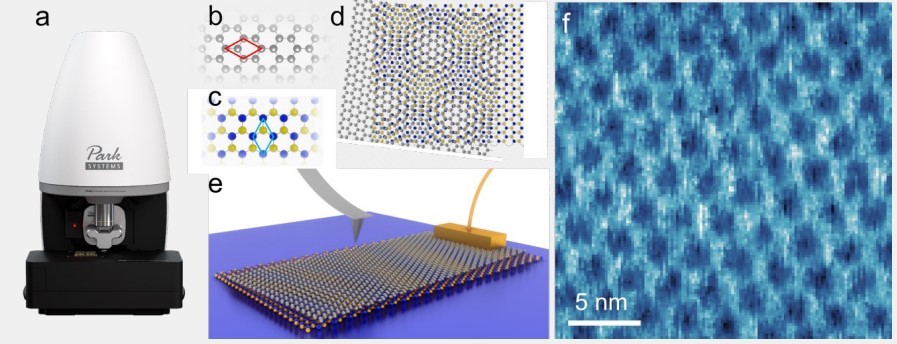
Figure 1. Using the Park Systems FX40 automatic AFM (a), C-AFM measurements were performed in contact mode to map the morphology of moiré patterns. A heterostructure of single layer graphene (SLG) (b) on hexagonal boron nitride (hBN) (c) was produced by stacking mechanically exfoliated flakes. The similar lattice constants of hBN and SLG give rise to a moiré pattern, as depicted for a twisted heterostructure (d). With an electrode applied to the substrate and the tip-sample interaction controlled via contact mode (e), current maps acquired under constant voltage may be measured (f) which reveal a hexagonal moiré pattern due to the spatially modulated stacking registry of hBN and SLG.
Conductive AFM utilises the same setup as contact mode AFM (with associated mechanical setpoint: SPMech) to maintain the tip in contact with the surface under constant mechanical load via a feedback loop which also allows the topography to be extracted. By applying an electrical contact to the sample and using a conductive probe, the current may be measured at the tip sample junction and mapped spatially with sub-nanometre resolution. Such current maps of SLG/hBN (see figure 1f and 2a) reveal a hexagonal moiré pattern with areas of higher current observed for the network of domain boundaries compared to the central regions where the lattices stack in a more parallel fashion [7]. When using C-AFM, structures are immediately observed in the in the current channel without significant modification of setpoints. The contrast of such features in AFM images may be impoved by optimising SPMech, the voltage applied between the tip and sample (VTS), increasing the scan rate to suppress thermal drift and changing the state of the tip by applying short and controlled pulses of higher voltage. Upon optimisation of the aforementioned acquisition parameters, current maps showing nanometre scale corrugations (see figure 2a and 2b) may be acquired, with extracted line profiles showing remarkable conformity.
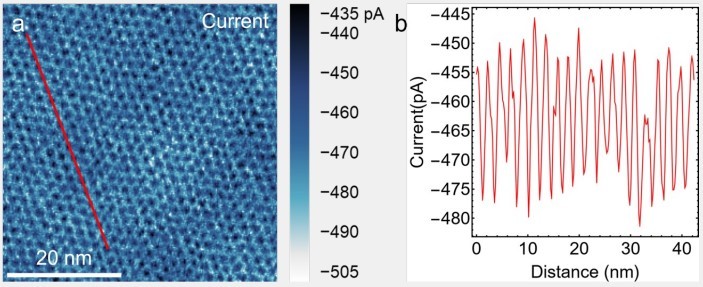
Figure 2. Using contact mode AFM, a current map (a) of SLG on hBN was measured with VTS = 1 V and SPMech ~ 260 nN with ElectriMulti75-G cantilevers, showing a uniform hexagonal moiré pattern in the current map, as shown in Figure 1. To measure the moiré period, a line profile was taken at an angle close to the fast scan direction (b), with an extracted mean spacing of 2.20 nm between local current maxima.
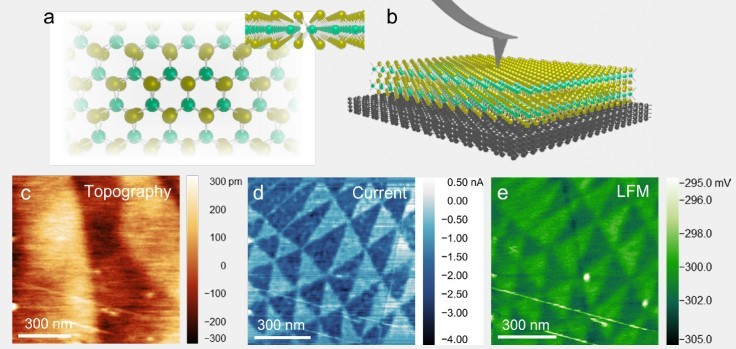
Figure 3. By deterministically breaking and re-stacking a single mechanically exfoliated 1L-MoS2 (a) on HOPG, parallel stacked (0°) registries of 2L-MoS2 can be studied using C-AFM (b). While no contrast is observed in the topography channel (c), regular triangular patterns are observed in both the current map (d) and lateral force map (e) due to differing stacking registries.
In general, for layered materials heterostructures, the intra-layer forces arising from bonding within layers are stronger than inter-layer forces arising from van der Waals interactions. For this reason, layered materials heterostructures typically exhibit moiré patterns as the stronger intra-layer interactions yield comparatively rigid layers which are not disrupted even when small relaxations may lead to favourable inter-layer adhesion energies [8]. In some special instances however, layered materials heterostructures may be formed between layers of the same or similar lattice constant and marginal twist angle (typically < 2°) such that interlayer interactions are sufficient to induce changes in the intra-layer structure, known as atomic reconstruction and demonstrated for the first time in marginally twisted bilayer MoS2 by Weston et al [9,10]. We fabricated such samples using the so called ‘tear and stack’ method [11], by first exfoliating 1L-MoS2 (SPI supplies) on polydimethylsiloxane (PDMS) using scotch tape. The flake was then brought partially into contact with a freshly cleaved highly oriented pyrolytic graphite (HOPG) surface and retracted, such that the flake broke, with part left on the HOPG before the remaining 1L-MoS2 on PDMS was aligned to the first flake and stacked on top. By breaking and restacking the same flake, the twist angle between two layers can be controlled deterministically (0° was used here). Before measuring using C-AFM, samples were annealed to 150 °C for 5 minutes in air before cooling to room temperature and scanned using contact mode AFM to promote the removal of contamination from the top MoS2 surface and buried interfaces. The cleaned 2L-MoS2 (0°) on HOPG was measured using C-AFM (see figure 3b) with VTS = 0.5 V and VSPMech~65 nN, with regular triangular domains observed in both the current and lateral force channels (see figure 3 d and e) but not in topography (see figure 3c). Contrast between current of AB/BA domains with stacking registries (offset by half a unit cell) was in good agreement with observations in the literature [9,12]. In addition to the current map, contrast was measured in the lateral force image (the deflection of the cantilever parallel to the scan direction and perpendicular to the cantilever) which implies differences in the mechanical interaction between the tip and 2L-MoS2 across different domains. Comparing different areas of the same 2L-MoS2 (0°) on HOPG sample, areas of comparatively regular triangular domain morphology (see figure 3d) are observed in addition to more distorted structures (see figure 4a), which we attribute to uneven distributions of strain induced mechanically during sample fabrication. In addition to measuring the morphology of such domains, C-AFM allows the current-voltage characteristics of the junction between the tip and sample to be measured from isolated locations. By performing arrays of point currentvoltage measurements across a premapped region, current voltage maps from specific domains may be measured, as shown in figure 4b, to isolate the properties of specific registries and gain insights into how local variations affect the performance of completed devices.
Conclusions
Stacking layered materials to form heterostructures may induce structural features such as moiré patterns and atomic reconstruction, which influences functional properties locally and at device scales. Here, we have shown that C-AFM enables such features in electrically conductive samples to be measured with nanometre scale resolution and highly relevant functional properties measured via mapping and spectroscopy. The advantage of C-AFM is that it provides information on the electrical properties of materials at nanometre length scales which are complementary to device characterisation techniques. Such insights are valuable both in exploring the fundamental properties of twisted layered materials heterostructures and in the optimisation of devices such as transistors, memristors, photodetectors and light emitting diodes.
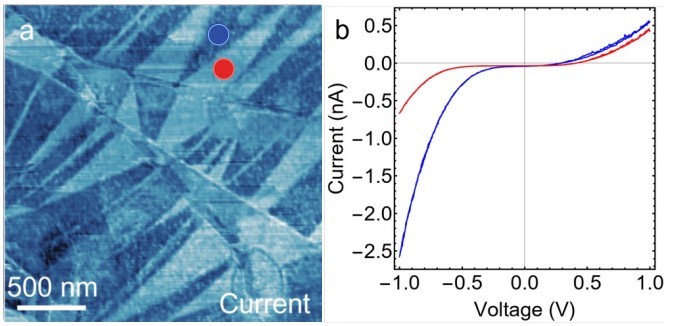
Figure 4. For the same parallel stacked 2L-MoS2 /HOPG sample shown in figure 3, a larger area current map was measured, revealing less regular distorted domains (a). By positioning the probe over specific domains, current-voltage curves may be measured (b), revealing differing characteristics over regions of high and low current contrast.
References
[1] E. Li et al. Nat Commun. 12, 5601 (2021).
[2] X. Wang et al. Nat. Nanotechnol. 17, 367 (2022).
[3] R. Ribeiro-Palau et al. Science 361, 6403, 690 (2018).
[4] Y. Cao et al. Nature 556, 80 (2018).
[5] C. Dean et al. Nat. Nanotechnol. 5, 722 (2010).
[6] D. G. Purdie et al. Nat. Commun. 9, 5387 (2018).
[7] C. Woods et al. Nature Phys. 10, 451 (2014).
[8] V. V. Enaldiev et al. PRL 124, 206101 (2020).
[9] A. Weston et al. Nat. Nanotechnol. 15, 592 (2020).
[10] A. Weston et al. Nat. Nanotechnol. 17, 390 (2022).
[11] K. Kim et al. Nano Lett. 16, 3, 1989 (2016).
[12] M. R. Rosenberger et al. ACS Nano 14, 4, 4550 (2020).
